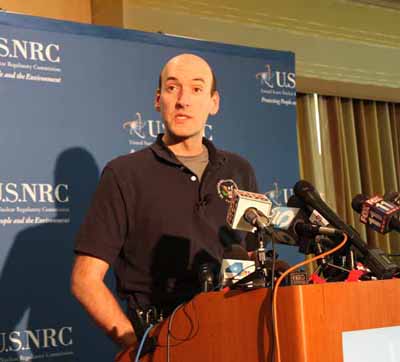Southern California faces a grim summer with electrical generation capacity stretched to the limit, as any prospects for a quick restart of the idled San Onofre Nuclear Generating Station (SONGS) now appear all but dead.
The beleaguered plant has been shut down for most of this year–Unit 2 since being taken offline in January for maintenance, and Unit 3 since a leak was discovered in a steam generator tube on Jan. 31. Last month, the Nuclear Regulatory Commission (NRC) ordered the plant to remain offline until the cause of the unusual wear was determined and corrected.
NRC Chairman Gregory Jazcko toured the facility with congressional representatives on Friday and told reporters at a press briefing afterward that neither unit would be allowed to restart until the causes of excessive tube wear in both reactors were determined and plans were in place for correction. This means significant delays are all but certain, as Jazcko revealed for the first time that the unusual wear in the two units might not be related.

NRC Chairman Gregory Jazcko answers questions about the problems at San Onofre Nuclear Generating Station at a press briefing on Friday. Photo by Tom Overton/POWER
Inspections so far have indicated that the wear in Unit 3 was being caused by excessive vibration of the tubes, which were rubbing against one another as well as against their support structures. The cause of this vibration is yet to be determined, but Jazcko noted that this sort of wear was "a very unique phenomenon."
The tubes in Unit 2 are showing more typical erosion, as the result of rubbing against the tube retainer bars. Jazcko stated that while this type of erosion is not unusual, the degree of wear is "on the high side" of what would be expected for so new a unit. However, the reasons for this accelerated erosion are still a mystery.
All four steam generators at SONGS were replaced within the past two years. Asked by POWER if the replacement might have changed the flow mechanics through the primary loops enough to cause the unusual vibration, Jazcko acknowledged this might be the case, but he emphasized that the inspectors were looking at all possible causes.
Jazcko also refused to speculate as to when the plant might come back online, stressing that until the full causes of the problems were determined, it was impossible to know when they might be corrected.
A number of local anti-nuclear groups have lobbied the NRC to shut down San Onofre permanently. After the press briefing, representative of one group, Friends of the Earth, distributed copies of a report by Vermont-based Fairewinds Associates, which alleged that Southern California Edison (SCE) had downplayed significant design changes that were implemented when the steam generators were replaced in order to avoid heightened NRC review. SCE has denied the charges, and Jazcko sidestepped a question on the subject, stating that all elements of the design were being carefully reviewed as part of the inspection process.
Right now, the primary loops at both units have been partially drained and the steam generators opened up for inspection of the tubes. Even if the problems were corrected soon, it would likely take weeks of refitting and testing before the reactors could begin supplying power again.
The ongoing loss of generation capacity from San Onofre has energy officials in Southern California increasingly worried that the summer heat and its consequent drain on the grid may result in rolling blackouts across the region. The California Independent System Operator (CAISO) warned in late March that without SONGS, the Los Angeles area is short approximately 240 MW of capacity under heavy load conditions, while San Diego is short 337 MW.
CAISO has issued a formal request to AES California to bring two retired gas-fired units at the Huntington Beach Power Plant back into service. The obsolete thermal generators had been shut down at the end of 2011 and were being decommissioned by Edison Mission Energy (EME), which owns the units but leases them back to AES. Both had been disconnected from the gas supply, and the boilers had been cut open to render them inoperable.
According to AES California President Eric Pendergraft, AES is currently in the process of securing the necessary permits and authorizations to bring the units back online. Once that is completed within the next week or so, it should take about three weeks to perform the necessary repairs to make the units operational.
The two units could provide up to 452 MW to the Los Angeles area once they are reactivated, in addition to enabling an additional 350 MW to be imported into the San Diego grid.
Sources: POWERnews, NRC, CAISO, AES







